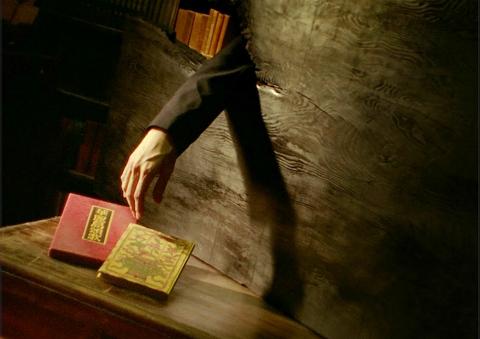Aesthetically speaking, Le Moulin (日曜日式散步者) is a beautiful, unique and creatively executed piece that captures the spirit of the surrealist French-influenced, Japanese-educated Taiwanese poets of the 1930s, an experimental documentary that meshes tastefully recreated scenes, evocative sequences, carefully selected details, poetry readings, historical photos and footage and text to create a multifaceted feature film that is almost like an extensive, epic ballad.
The film focuses on the Le Moulin Poetry Society, founded in 1935 by Yang Chih-chang (楊熾昌), Lee Chang-juei (李張瑞) and Lin Hsiu-er (林修二), who were proponents of French surrealism but wrote in Japanese, as many of the Taiwanese elite did at the time. Le Moulin only lasted a year, but the story follows the writers’ literary endeavors and correspondence up to the end of Japanese rule and the demise of their art form during the White Terror era.
The film’s driving narrative is the recreated scenes of these literary compatriots interacting with each other, carrying a loose focus on Lin as it delves into his home life and marriage. Few faces are shown, just hands, movement and voices, which is an inventive way to represent a past era. Notable publications are cleverly inserted into recreated scenes, and there’s also great deal of poetry, whether in text or through readings. There’s also plenty of historical found footage, providing background of the conflict on cultural, political and economic fronts during turbulent times.

Photo courtesy of atmovies.com
Here’s the problem though: there’s a reason why poetry is often short and sweet. The concept for the film is refreshing — but no movie without a comprehensible storyline, tension or memorable characters should be 162 minutes long. The first hour or so was enjoyable — and it should have ended there, but the film continued to mosey on at a snail-like pace without an end in sight.
There is ground to cover, as the story spans several decades. But like any film, it can be condensed, and probably should have been. There is too much crammed in here, as the “story” is bogged down by poetic and picturesque stylings that are delightful at first but become tiresome after a while. Even the ending simply wouldn’t end after the plot had already concluded, with atmospheric scene upon atmospheric scene leading to suffocation.
Perhaps it is not a surprise that director Huang Ya-li (黃亞歷), a young experimental filmmaker, had only produced short films before Le Moulin. His 2008 work The Pursuit of What Was (物的追尋), lasted only 22 minutes, and the 2010 The Unnamed (代以名之的事物) ran for an even shorter 11 minutes. The difficulty in transition from shorts to feature is obvious here for the aforementioned reasons.
Huang “discovered” the poetry society in Lin’s thesis while doing research on Taiwanese surrealism. After half a year of research and field study, he decided to put the film together.
Alas, this is the type of film that infallibly garners rave reviews at the international festival circuits, promoting local arthouse filmmakers to churn out more uncompromising films like Le Moulin. There is definitely an audience for this type of film, but with such a promising idea — especially one depicting such a little known slice of Taiwanese history — one would wonder if it could have been edited to be a bit more suitable for the general public. But then, would that be compromising the director’s artistic vision? After all, it’s not meant to be a mainstream film, and maybe that’s why high art and pop culture don’t often mix.

In late October of 1873 the government of Japan decided against sending a military expedition to Korea to force that nation to open trade relations. Across the government supporters of the expedition resigned immediately. The spectacle of revolt by disaffected samurai began to loom over Japanese politics. In January of 1874 disaffected samurai attacked a senior minister in Tokyo. A month later, a group of pro-Korea expedition and anti-foreign elements from Saga prefecture in Kyushu revolted, driven in part by high food prices stemming from poor harvests. Their leader, according to Edward Drea’s classic Japan’s Imperial Army, was a samurai

Located down a sideroad in old Wanhua District (萬華區), Waley Art (水谷藝術) has an established reputation for curating some of the more provocative indie art exhibitions in Taipei. And this month is no exception. Beyond the innocuous facade of a shophouse, the full three stories of the gallery space (including the basement) have been taken over by photographs, installation videos and abstract images courtesy of two creatives who hail from the opposite ends of the earth, Taiwan’s Hsu Yi-ting (許懿婷) and Germany’s Benjamin Janzen. “In 2019, I had an art residency in Europe,” Hsu says. “I met Benjamin in the lobby

April 22 to April 28 The true identity of the mastermind behind the Demon Gang (魔鬼黨) was undoubtedly on the minds of countless schoolchildren in late 1958. In the days leading up to the big reveal, more than 10,000 guesses were sent to Ta Hwa Publishing Co (大華文化社) for a chance to win prizes. The smash success of the comic series Great Battle Against the Demon Gang (大戰魔鬼黨) came as a surprise to author Yeh Hung-chia (葉宏甲), who had long given up on his dream after being jailed for 10 months in 1947 over political cartoons. Protagonist

The following three paragraphs are just some of what the local Chinese-language press is reporting on breathlessly and following every twist and turn with the eagerness of a soap opera fan. For many English-language readers, it probably comes across as incomprehensibly opaque, so bear with me briefly dear reader: To the surprise of many, former pop singer and Democratic Progressive Party (DPP) ex-lawmaker Yu Tien (余天) of the Taiwan Normal Country Promotion Association (TNCPA) at the last minute dropped out of the running for committee chair of the DPP’s New Taipei City chapter, paving the way for DPP legislator Su